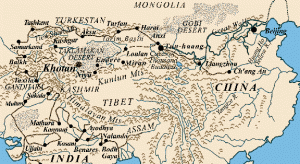China’s dependence on Jade to carry out rituals is a well-documented aspect of their ritual culture. Although the primary stone for Chinese sculpture has been native to regions in China such as the Yangtze River, Jade imported to China during the Tang Dynasty (618-907 AD) is common, causing the push for international relationships to be established with countries and regions outside of China proper including India and Khotan.
Outside the Universe of China
–Khotan
- Modern-day Xinjiang, China.
- Positioned near the Kunlun mountain range.
- Major Oasis town along the Silk Road.
- Famous for nephrite Jade.
- Flourished via trade with the Chinese.
- Tribute Relationship formed.
- The new fashion in court girdles further marks the importance of Khotan Jade.
- The Jade girdle above, or one just like it, gifted from the King of Khotan to the emperor of the Tang Dynasty.
- The decline in the Silk Road causes the subsequent fall of this once major Oasis town.
-Middle East
- Umayyad Caliphs.
- Emir Suleiman sends an envoy which contained Jade among other commodities.
- China pursues a relationship with India after the depletion of Jade in China and the fall of Khotan.
- India recognizes the importance of Jade in Chinese culture.
- India becomes a “middle ground” between China and Europe.
- Trade around Jade strengthens the flow of commerce from China to the middle east.
- Bactria – Ancient country northwest of India. Present day “the stans” located in Central Asia.
- Bacteria recognized as an area, along with some of it’s neighboring regions, that sent Jades to the Imperial courts from the Han Dynasty throughout the Tang Dynasty.
To conclude the importance of Jade in Chinese international relationships, a depletion of Jade in China initiated the need to find a source of it elsewhere. Trade routes to Khotan can be traced back to approximately 1200 BCE. The importance of Jade in China set the early groundwork upon which the Silk Road is built, allowing China to build and maintain relationships with other countries and regions, and for trade to flourish during the Tang Dynasty.
References
Keene, Manuel. “Old World Jades Outside China, From Ancient Times To The Fifteenth Century: Section One.” Muqarnas Online, vol. 21, no. 1, 2004, pp. 193–214., doi:10.1163/22118993-90000065.
Laufer, Berthold. “Jade: a Study in Chinese Archaeology and Religion.” 1912, doi:10.5962/bhl.title.3503.
Wood, Frances. The Silk Road: Two Thousand Years in the Heart of Asia. University of California Press, 2002.



